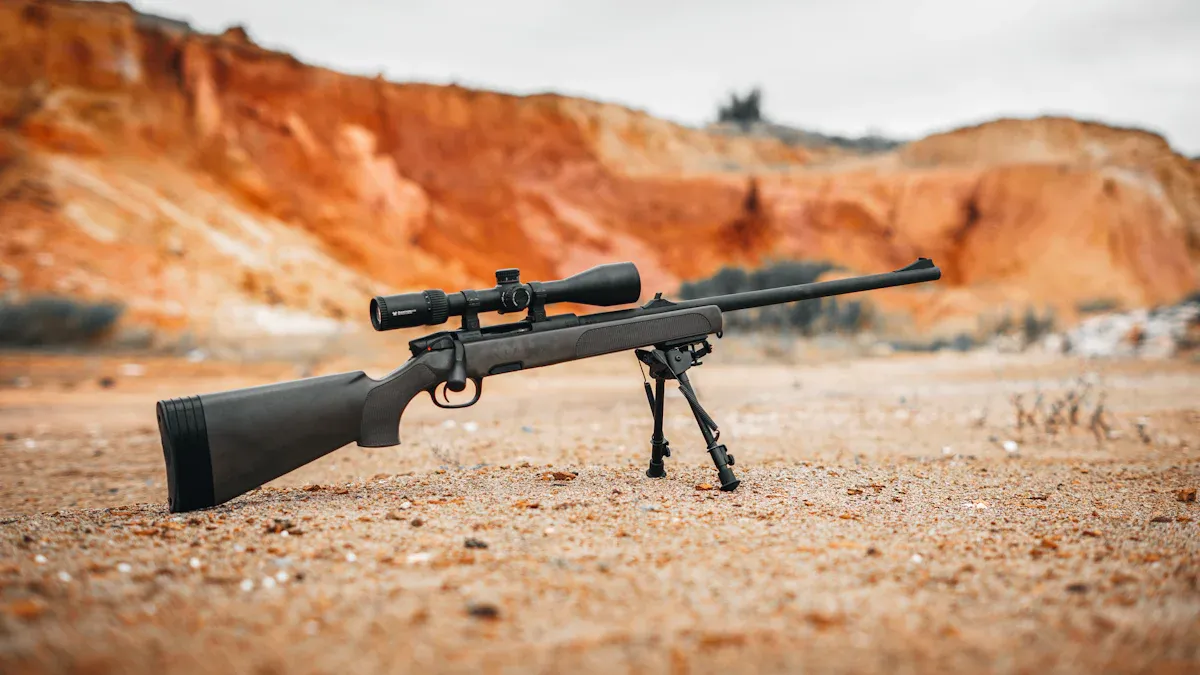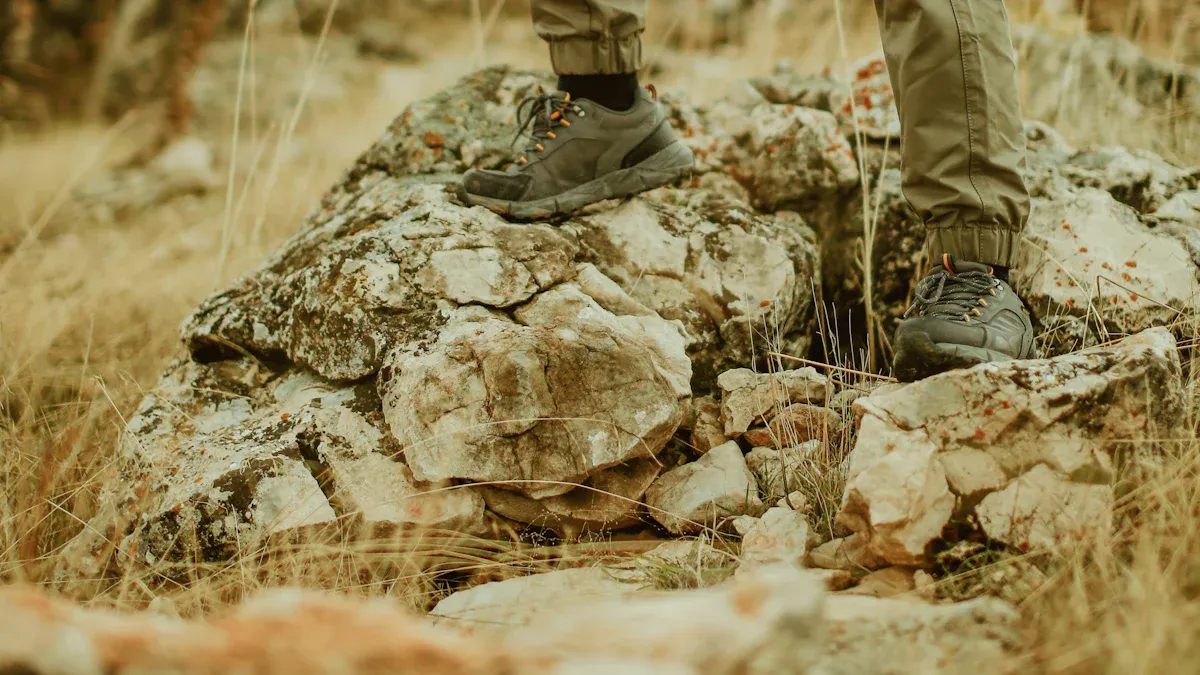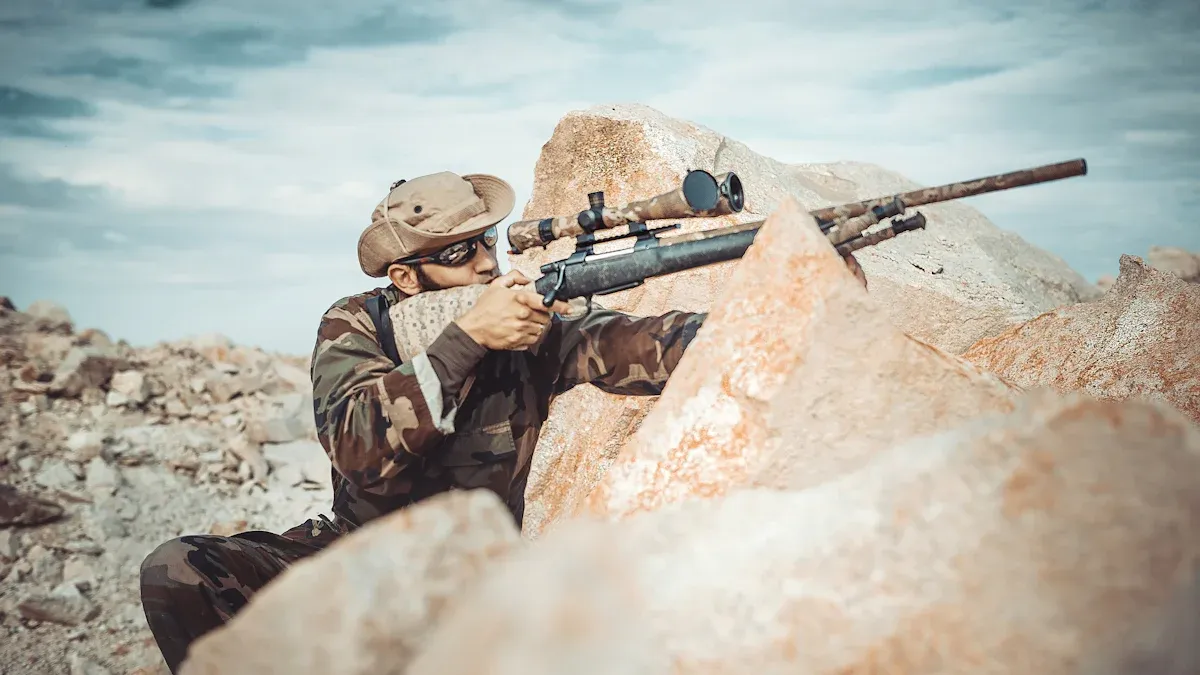
Hunting on rocky terrain feels like balancing on a seesaw—unpredictable and tricky. A rifle bipod transforms this chaos into calm. Its V-shaped design boosts comfort and accuracy, even on uneven ground. Lightweight materials and adjustable legs make it a hunter’s best friend. Pair it with a rifle scope and sturdy rail mount, and you’re unstoppable. Accessories like these ensure every shot counts.
Key Takeaways
- A rifle bipod helps keep your aim steady on rocky ground. It lets hunters change the leg height for uneven spots, making shots more accurate and less tiring.
- Pick a bipod made of strong materials like aluminum or carbon fiber. These materials last in tough weather and work well for a long time.
- Think about how you hunt when picking a bipod. Light ones are great for long walks, while stronger ones work better for big rifles.
Why a Rifle Bipod is Essential for Rocky Terrain

Challenges of Hunting in Rocky Terrain
Hunting in rocky terrain is like playing a game of chess with nature. Every step presents a new challenge. Hunters often face uneven surfaces, loose rocks, and steep inclines. These conditions make it difficult to find a stable shooting position. Wildlife, such as the elusive Canada lynx, struggles in these environments too. Limited understory and habitat destruction from wildfires and urbanization add to the complexity. For hunters, this means fewer opportunities and more obstacles to overcome.
How a Rifle Bipod Enhances Stability and Accuracy
A rifle bipod transforms chaos into control. Its adjustable legs allow hunters to stabilize their rifles on uneven ground. Quick deployment features, like those found in the Harris bipod, ensure hunters can transition between shooting positions without missing a beat. Cant adjustment, provided by tools like the RRS Harris adapter, helps level the rifle on rocky surfaces. Users report improved accuracy when applying pressure to the bipod, creating a stable shooting platform. Proper body positioning and tensioning the bipod further enhance stability, allowing for precise shots even in challenging conditions.
Real-Life Example: A Hunter’s Experience in the Rocky Mountains
Earlier in the morning, amid the dew-covered aspens, a hunter drew the wooden limbs of his father’s longbow. He released an arrow into a bull elk from 12 yards away. This moment was the result of weeks of hard hunting, miles of steep hiking, and years of preparation. It was a testament to the importance of the right tools and techniques in the field.
Hunters contribute significantly to conservation efforts, spending over $1.6 billion annually in the U.S. Their dedication ensures the preservation of habitats and wildlife for future generations.
Key Features to Look for in a Rifle Bipod for Rocky Terrain
Leg Adjustability for Uneven Surfaces
Rocky terrain rarely offers a flat spot to set up. A rifle bipod with adjustable legs becomes a lifesaver in these situations. Hunters can extend or retract the legs to match the uneven ground, ensuring a stable shooting position. The Odin Works Prism Precision Bipod, for instance, features a 45-degree tilt and a swivel function. These allow users to adapt quickly to challenging surfaces without repositioning the entire setup. Such flexibility can mean the difference between a missed opportunity and a successful shot.
Material Durability for Harsh Conditions
Harsh environments demand tough gear. A durable rifle bipod can withstand the wear and tear of rocky terrain. Materials like stainless steel and aluminum excel in these conditions. Stainless steel resists corrosion and handles heavy loads, while aluminum offers a lightweight yet strong alternative. Carbon fiber, used in the MTN Gear Mountain Bipod, adds silent adjustments and durability. Stress and environmental testing ensure these materials perform well under extreme conditions, from UV exposure to mechanical stress.
Lightweight Design for Portability
Hiking through rocky terrain with heavy gear can exhaust even the most seasoned hunter. A lightweight rifle bipod reduces this burden. The MTN Gear Mountain Bipod, made with carbon fiber, is a prime example. Its design prioritizes portability without sacrificing stability. Hunters can carry it for miles without feeling weighed down, making it ideal for long treks.
Attachment Compatibility with Different Rifles
Not all bipods fit every rifle. Compatibility depends on the attachment system. Common options include sling swivel studs, Picatinny rails, and ARCA rails. Each has its strengths. Sling swivel studs are lightweight but less secure. Picatinny rails offer quick attachment and detachment, though they may need adjustments for different rifles. ARCA rails, popular with precision shooters, provide secure and fast repositioning. Choosing the right attachment ensures the bipod works seamlessly with the rifle.
| Attachment Type | Compatibility Notes |
|---|---|
| Sling Swivel Stud | Common on hunting rifles; lighter but less secure than other options. |
| Picatinny Rail | Quick attachment/detachment; may require adjustments between different rifles. |
| ARCA Rail | Increasingly popular for precision rifles; allows quick repositioning and is secure. |
Case Study: Comparing Rifle Bipod Features in Real-World Use
A side-by-side comparison of six popular bipods revealed their strengths and weaknesses. The Blackhawk Sportster Bipod stood out for its affordability and features like height adjustment and a pan/tilt mechanism. However, it showed wear after extensive use. Meanwhile, the Odin Works Prism Precision Bipod excelled in stability and adaptability, thanks to its rubber feet and swivel function. These real-world tests highlight the importance of choosing a bipod that matches the hunter’s specific needs.
Top Recommendations for Rifle Bipods
Best Overall Rifle Bipod for Rocky Terrain
The Atlas BT46-LW17 PSR Bipod earns the crown for rocky terrain. Its robust aluminum construction and adjustable legs make it a favorite among hunters. The bipod’s ability to pan and tilt ensures stability on uneven surfaces. Hunters rave about its versatility, using it for everything from steep inclines to flat plains. The quick-detach Picatinny mount adds convenience, allowing users to switch rifles effortlessly. While it’s a premium option, its durability and performance justify the investment.
Best Budget-Friendly Option
For hunters seeking affordability without sacrificing quality, the Magpul MOE Bipod stands out. Lightweight and made of polymer, it delivers solid performance at just $75. Its compact design and ease of use make it ideal for beginners or those on a tight budget.
| Feature | Details |
|---|---|
| Recommended Model | Magpul MOE Bipod |
| Price | $75 |
| Weight | 8oz |
| Material | Polymer |
| Performance | Solid performance, highly rated for budget category |
Best Lightweight Rifle Bipod for Long Hunts
Long treks demand gear that won’t weigh hunters down. The Spartan Javelin Pro Hunt Tac Bipod excels in portability and versatility. It’s easy to remove and adapts to various shooting positions. Other contenders include:
- MDT CKYE-POD Lightweight Double Pull: Highly adjustable and durable, but requires maintenance.
- Magpul Bipod: Affordable and simple to deploy, though less durable.
Best Heavy-Duty Rifle Bipod for Large Caliber Rifles
Heavy calibers demand rugged bipods. The UTG BIG BORE Bipod handles .50 BMG and .338 Lapua with ease. Its steel feet and large deployment buttons ensure stability for long-distance shots.
| Bipod Model | Material | Weight | Height Range | Suitable Calibers | Features |
|---|---|---|---|---|---|
| UTG Super Duty | Steel and Aluminum | 13.8 oz | 6.0″ – 8.5″ / 8.0″ – 12.8″ | AR-10, AR-15, Heavy Rifles | Quick detach, rubber feet, locking thumbwheels, sturdy construction |
| UTG BIG BORE | Steel and Aluminum | 2 lbs | 9″ – 14″ | .50 BMG, .338 Lapua | Forward tilting steel feet, large buttons for deployment, stability for long-distance shots |
Example: User Reviews and Field Testing Results
Hunters praise the Atlas BT46-LW17 PSR Bipod for its reliability in extreme conditions. Field tests show the Magpul MOE Bipod performs well for its price, though it struggles under heavy loads. The Spartan Javelin Pro Hunt Tac Bipod receives high marks for portability, while the UTG BIG BORE Bipod dominates in heavy-duty scenarios. These reviews highlight the importance of matching bipods to specific needs.
How to Choose the Right Rifle Bipod for Your Needs
Assessing Your Hunting Style and Rifle Type
Choosing the right rifle bipod starts with understanding your hunting habits and rifle setup. Are you a weekend warrior or a seasoned hunter who ventures out more than 15 times a year? Do you prefer long-range precision or quick, reactive shots? These questions shape your choice. For example, a lightweight bipod suits hunters who hike long distances, while a heavy-duty model works better for those using large-caliber rifles.
Hunters can use tools like surveys to evaluate their needs. Here’s a quick guide:
| Question | Response Options |
|---|---|
| How often do you go hunting/shooting? | Less than once a year, Once a year, Less than 15 times a year, More than 15 times a year |
| How important is a lightweight bipod? | 1 (low) to 5 (high) |
| Do you have trouble steadying your gun for long periods? | YES, NO |
| Willingness to pay for a rest system? | $0-$25, $26-$50, $51-$75, $76-$100, $100+ |
Answering these questions helps narrow down the options.
Balancing Budget and Performance
Hunters often face a dilemma: affordability versus quality. A budget-friendly bipod like the Magpul MOE offers decent performance for casual outings. However, frequent hunters may find premium options like the Atlas BT46-LW17 more reliable. Investing in a durable bipod saves money in the long run by avoiding frequent replacements. Prioritize features that align with your hunting style to strike the perfect balance.
Evaluating Terrain-Specific Requirements
Rocky terrain demands a bipod with adjustable legs and a sturdy build. Features like cant adjustment and rubber feet ensure stability on uneven surfaces. For damp or slippery ground, carbon fiber models provide durability and silent adjustments. Hunters in open plains might prioritize lightweight designs for portability. Matching the bipod to the terrain ensures better performance and comfort during hunts.
Example: Matching a Rifle Bipod to a Specific Hunting Scenario
Imagine a hunter preparing for a long-range elk hunt in the Rocky Mountains. The terrain is rugged, with loose rocks and steep inclines. A rifle bipod with adjustable legs and a swivel function becomes essential. The hunter chooses the Atlas BT46-LW17 for its stability and versatility. This decision enhances accuracy and reduces fatigue, leading to a successful hunt. Selecting the right bipod transforms challenging conditions into manageable adventures.
Tips for Using a Rifle Bipod on Rocky Terrain

Setting Up Your Rifle Bipod for Uneven Ground
Setting up a rifle bipod on rocky terrain can feel like solving a puzzle. Each rock and crevice presents a new challenge. Start by finding a relatively stable surface. Extend the bipod legs to match the height of the uneven ground. If one leg sits on a higher rock, adjust it to keep the rifle level. Rubber feet or spiked feet on the bipod can grip the surface better, preventing slips. Hunters often recommend Swagger Bipods for their flexible leg system, which adapts well to rugged terrain. A solid shooting rest, such as a flat rock or a sturdy log, can also improve stability.
Adjusting Leg Angles for Maximum Stability
Adjusting the leg angles of your bipod is like fine-tuning a musical instrument. It requires precision. Spread the legs wide for a lower center of gravity, which enhances stability. For steep inclines, angle the legs to counterbalance the slope. Field experiments show how leg adjustments impact stability. The table below highlights key findings:
| Figure | Description |
|---|---|
| 21a | Joint angles of the back-left leg during impact, showing measured vs. desired values. |
| 21b | Vertical force at all leg foot-ends during stance and flight phases. |
| 21c | Attitude angles affected by lateral impact, with maximum deflection of 11°. |
| 21d | Range of attitude angles in experiments vs. simulations, showing control differences. |
These insights emphasize the importance of proper leg adjustments for maintaining balance.
Maintaining Your Rifle Bipod for Long-Term Use
A well-maintained rifle bipod lasts longer and performs better. After every hunt, clean the bipod to remove dirt and debris. Use a soft cloth to wipe down the legs and joints. For metal bipods, apply a light coat of oil to prevent rust. Check for loose screws or bolts and tighten them as needed. Store the bipod in a dry place to avoid moisture damage. Regular maintenance ensures your bipod remains reliable, even in harsh conditions.
Example: Practical Tips from Experienced Hunters
Experienced hunters share valuable tips for using a rifle bipod effectively:
- Use a surface to load against, like a board or a rock, to enhance stability.
- Lean into the rifle’s buttstock to create a firm connection with the bipod.
- Opt for bipods with large, spiked feet for better grip on uneven ground.
These strategies, combined with the right bipod, can turn a challenging hunt into a successful one.
Choosing the right rifle bipod transforms a challenging hunt into a rewarding adventure. Stability, adjustability, and durability ensure success in rocky terrain. Military units rely on stable bipods for mission success, while NATO forces favor lightweight, adjustable designs for effectiveness. The table below highlights these essential features:
| Feature | Importance |
|---|---|
| Stability | Enhances performance in uneven terrain, critical for military and hunting success. |
| Adjustability | Lightweight designs improve adaptability and operational efficiency. |
| Speed of Deployment | Quick setup under 1.5 seconds ensures readiness in dynamic situations. |
| Recoil Management | Reduces recoil impact, improving shot accuracy by 40%. |
| Interoperability | Compatibility with various systems supports versatility in the field. |
Hunters should assess their needs and invest in a quality rifle bipod. The right choice boosts accuracy, comfort, and confidence, making every shot count.
FAQ
What makes a rifle bipod essential for rocky terrain?
A rifle bipod provides stability on uneven surfaces. Hunters can adjust the legs to match the terrain, ensuring accurate shots and reducing fatigue during long hunts.
Can a lightweight bipod handle heavy-caliber rifles?
Yes, some lightweight bipods, like the Spartan Javelin Pro Hunt Tac, balance portability with strength. They use durable materials like carbon fiber to support heavy calibers.
How do hunters maintain their rifle bipods?
Hunters clean their bipods after every use. They tighten loose screws, apply oil to metal parts, and store them in dry places to prevent rust or damage.
Pro Tip: Always carry a small toolkit for quick bipod adjustments in the field. It can save the day during unexpected challenges!
Post time: Apr-03-2025
